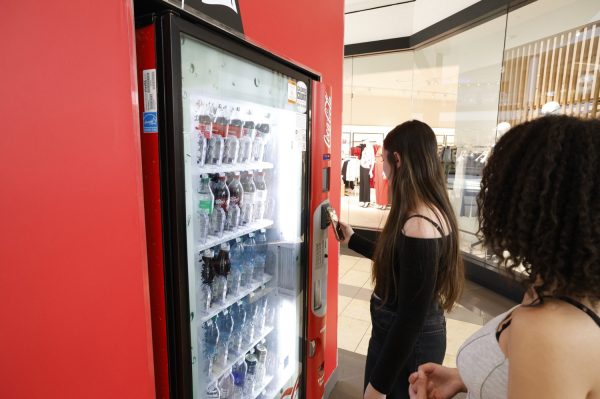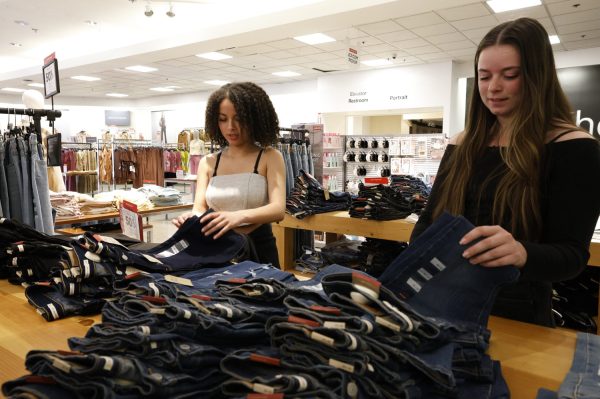I remember sitting in my parents’ house in California talking on the phone with my apartment’s leasing office in Las Vegas. As I asked, “So, how much would it be to break my lease?” I already knew the answer wouldn’t be good, but when the representative casually dropped, “That’ll be $3,000,” my stomach sank. Saving up to $3,000 felt impossible on top of everything else life throws. The only other option was paying $500 a month for a place I didn’t even live in anymore. That was it—I was stuck.
Senior year of high school, I had planned to go to college out of state. I was looking for something different, a life-changing adventure. I loved the fact no one would know me. I could wear whatever I wanted, go wherever I wanted, and do anything I wanted. I was looking for schools in three states: Oregon, Nevada or Arizona. I chose Las Vegas because it was the most inexpensive option, and I could be more financially stable. One day towards the end of senior year of high school, my roommate found a decent apartment listing online. We applied, packed our things and drove out there. When we got there, it really hit us. We are really doing all this. The excitement quickly shifted as reality set in. I was already overwhelmed by paying half of the rent that summer. By researching the cost of out-of-state tuition and travel expenses to visit my family frequently, I just knew I would be even more overwhelmed. I felt out of place and homesick. The more I thought about it, the more I realized it wasn’t realistic. So, I decided to move back home to my parents’ house in Anaheim, California. But my lease was for 18 months. I wanted to go out of state because it seemed like that’s what everyone at my high school was doing. And now, I was paying the price—literally.
I chose to start school at Fullerton College because I wanted to continue my education without the high costs of out-of-state schooling. At the end of the day, attending a community college allowed me to save more money. So, here I am, living in California, splitting rent with an old roommate for a place out of state every month, while juggling the costs of being a college student in Orange County. My situation is specific, but I know I’m not the only one who’s dealing with a lease contract that’s hard to get out of. Most college students, especially community college students in expensive areas like Orange County, struggle to pay for their lives. There are so many hidden costs we never expected.
At Fullerton College, it’s $46 dollars per unit for tuition. While that may seem affordable, that quickly adds up. A three-unit class costs $138, and if I take four classes, that’s $552. On top of that, there are additional expenses like a parking permit ($40), textbooks ($100 and up), and school supplies ($100). Rent, gas, meals, textbooks, school fees—it all adds up in ways you don’t expect. Luckily, I don’t have to pay rent at my parents’ home, but I still do in Las Vegas. So that adds up to $500 for rent, plus $60 for my phone bill, $30 for my gym membership, $42 for my subscriptions, $200 for groceries, and $30 for my kitten’s pet insurance. With inflation making everything more expensive, budgeting feels like a never-ending battle between what I need and what I can actually afford.
I try to save money by using student discounts. I get a discount on train tickets and some stores. Some stores at the mall offer student discounts, making clothes and other things more affordable. I also use student discounts at the grocery store, which helps me save on food. These discounts don’t cover everything, but they make a small difference and help me manage my expenses. I didn’t qualify for financial aid with my two jobs when I started at Fullerton College, but I recently had to quit one job because it interfered too much with school. After expenses, it’s hard to afford normal things I want like coffee or buying stuff for my kitten, Pluto. Financial stress always seems to be there.
Recently, I was at Target and really wanted to pick up a scratching post for Pluto, but after looking at the $90 tag on it and my budget, I realized I couldn’t afford that and the food I went there to get for my siblings. In the end, I bought the food and promised Pluto I’d get it for him next time. Moments like that make budgeting feel tiring. The financial stress never goes away.
How to afford college in Orange County
It’s not just me struggling—Orange County is one of the most expensive places to be a college student. According to data from the U.S. Bureau of Labor Statistics, the cost of living in Southern California is over 50% higher than the national average. Rent alone in Fullerton averages around $2,000 for a one-bedroom, making it nearly impossible for students to live independently without multiple roommates or financial aid.
Beyond rent, inflation has made everyday essentials more expensive. Gas prices in California are consistently among the highest in the country, averaging around $4.50-$5 per gallon. Even basic groceries like eggs and milk have nearly doubled in price recently. For students working part-time or relying on financial aid, keeping up with these costs is exhausting.

Some students are lucky enough to have resources like CalWORKs, a program designed to help low-income students balance school and life expenses. Mayra Novasky, a CalWORKs counselor at Fullerton College, explained the importance of these resources. “We provide educational and career counseling, childcare assistance, and even financial aid support,” she says. “Many of our students are parents, so the financial help makes a big difference.” Programs like CalWORKs offer textbook vouchers and emergency grants, relieving some financial pressure. “It’s not just about the money,” Novasky adds. “We also help students build confidence and feel supported through their educational journey.” While not all students qualify, those who do often describe it as a lifeline.
For students like me, it’s hard without financial aid. Fullerton College has programs like the Promise Program, which covers tuition for first time students, and they offer a $100 textbook voucher, and meal deals to help students save money. These resources can make a difference, but a lot of us don’t know about them.
In addition to financial aid, Novasky made clear the importance of utilizing campus resources like the food bank, which provides groceries and referrals to other community-based programs. She also suggested that students should consider work-study opportunities, which offer flexible on-campus jobs that don’t affect cash aid grants.
For students hesitant to apply for assistance programs, Novasky suggests seeking guidance CalWORKs counselors, financial aid advisors, academic counselors, social workers, or even student advocates. She encourages students to ask questions and explore all the available resources that are offered to help with financial stress. CalWORKs also offers budgeting workshops, where students learn practical financial management skills.
Logan Alvarez’s story: Trying to save by not spending
Logan Alvarez knows the struggle of being a college student. He’s a first-year kinesiology major, living in Brea. Alvarez doesn’t rely on student discounts or free resources to save money. But that doesn’t mean he’s not feeling the pressure of unexpected costs.
“I didn’t expect to pay for parking for each semester, so I had a ticket,” he says. Students had to start paying $40 each semester for parking again in Fall 2024, after getting free parking during the pandemic. Alvarez’s unexpected ticket was around $45. He says he has savings and earns around $1,000 per month from his job at Chipotle, but he estimates that after his expenses like his car payments, he has about $100 left per month to spend on things he wants.
Logan’s necessary personal expenses are gas and oil changes. He spends about $60 on gas weekly and $30 on oil change monthly. Alvarez recalls a moment when he had to choose between filling his gas tank and buying something he wanted. “I needed gas, but I also really needed a new skateboard deck,” he says. “I had to pick between them. Of course I picked the skateboard deck,” he admits.
One area he tries to save is paying for food. “For example, if I can eat at home, I will, instead of going out and eating. So, for me that’s a big way that I cut on costs,” he says. But it’s not always easy. “It can be hard at times because my other friends go out to eat a lot and spend money on food, too, so not spending my money on food can be difficult.”
He admitted that financial literacy wasn’t something he was taught growing up. “No, I feel like I was told, but not shown about it,” Alvarez explains. Alvarez filed for FAFSA, a form used by students to apply for financial aid, and when asked if it was helpful, his response was a blunt: “I didn’t get anything.” While he hasn’t had to take out student loans yet, it’s something he’s thought about. “It’s defiantly an option I’m willing to consider, but if I can avoid it, I’ll try. But I feel at some point I’ll have to do it.”
Alvarez’s long-term goal remains simple. “Have just the necessary amount of money to provide for myself.” For now, he’s doing what he can to work toward that goal: “I am working at my current job for that.”
Gracie Saliby’s story: Paying for “ungirly” expenses
Gracie Saliby, a first-year business major at FC who lives in Placentia, relies on discounts to help save money. “If it’s available and I know about it, I’ll use a student discount,” she says. “For example, I was buying shoes at Converse and there was a student discount for it, so I used it. But otherwise, I like to save money.”
Still, budgeting is a challenge for her. At the beginning of the month, her paychecks from In-N-Out typically total around $900, but her necessary expenses cut that number down quickly. “I’m usually tight on money after my expenses because I get paid biweekly,” she says. “I usually have $200 left over to spend on gas and food.” Some expenses might shift depending on her priorities for that month, and in months when expenses exceed her income, she may cut back on non-essential purchases or rely on savings to make ends meet.

She guesses that about 75% of her earnings go to necessary expenses like gas, food and paying back personal debts takes priority. “For my debt stuff, I pay my dad $300, and then my brother $300 a month,” she says. When it comes to tracking her spending, Saliby admits, “I just wing it. I don’t keep track, which is probably my issue. I try, but it’s failed.” To save money, she tries to limit spending on non-essentials. “If I have a lot of self-control, I’ll cut back on coffee or getting a sweet treat.”
And like Alvarez, she pointed out how the cost of gas is one of her biggest frustrations. “Gas is so expensive. Why do I have to spend my own girl money on not girly things?” she jokes. “But that’s just life, so it is what it is.” There have been times when Saliby has to make tough financial choices. “It’s usually food and gas,” she says. “Like, am I going to spend money on lunch or am I going to fill up my gas tank?” She also asks her dad for help here and there.
If she could change one thing about the cost of college, it would be the price of textbooks and supplies, a common complaint among students. Saliby also tries to avoid student loans for now, though she understands that transferring to a four-year university might change that. “I don’t like it, because I don’t want more stuff to pay off,” she says.
Looking back financially, she acknowledges the struggles. “College is expensive. Everything is expensive. Money goes away quick,” she says. “In high school, I had fewer expenses, so I’d just spend money on random stuff and not think about it. Now, I think a lot more about where my money is going.” Her financial goal is also clear–to build solid savings so she won’t have to worry about unexpected expenses. “Finacial stability, that’s the goal.”
We all have goals of financial stability, but that can feel so far off when you’re in college.
Every day feels unbalanced. Wake up, check my bank account, hoping there’s enough to cover expenses, and then try to make it through the day without spending too much. Some days, I bring food from home and resist the urge to grab a coffee. Other days, I swipe my card and tell myself, I’ll budget better… next month.
This appeared in the Summer 2025 print issue of Inside Fullerton.




